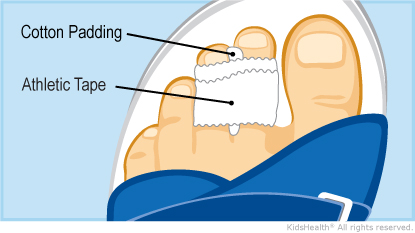Dislocated Toe: How to Care for Your Child
With proper treatment, most kids who dislocate a toe can gradually return to their normal activities. The toe may feel sore or stiff for a while.


A dislocation is when the bones in a joint slip out of their normal position. A dislocated toe may happen from a blow or jamming the toe, such as bumping the toe into furniture or during sports.
Your child had x-rays to diagnose the dislocated toe. The bones may have moved back into place on their own, or the health care provider may have gently put the joint back with a quick maneuver called a reduction. In some cases, surgery is needed to repair the joint.
To keep the joint from dislocating again, the health care provider may have taped the injured toe to the neighboring toe ("buddy taping"). Buddy taping is generally needed for a few weeks. The health care provider may also recommend gentle foot or toe exercises to help reduce stiffness.

-
For the next few days:
-
To keep swelling down, your child should keep the foot raised above heart level as often as possible. Try propping it up with pillows.
-
If your child is uncomfortable, a medication may help:
-
For children under 6 months, you may give acetaminophen.
-
For children over 6 months, you may give acetaminophen OR ibuprofen, if recommended by your health care provider.
-
If your health care provider recommended foot or toe exercises, your child should do them as instructed.
-
Do not remove tape from the toe unless instructed by the health care provider to do so.
-
If you are instructed not to remove the tape, prop the toe out of the bath tub to keep it dry.
-
If your health care provider says it if OK to remove the tape, change it each day as you were shown or anytime it becomes wet or soiled.
-
To reduce stress on the toe, have your child wear hard-soled shoes.
-
If your health care provider recommends crutches, your child should use them as instructed.

-
Schedule a follow-up appointment with an orthopedic doctor (bone specialist) or a podiatrist (foot specialist) as directed.
-
Ask your health care provider when it's OK for your child to return to sports.

-
The toe dislocates again.
-
Toe tape is too tight or causes skin irritation.
-
Swelling doesn't improve with home treatment.
